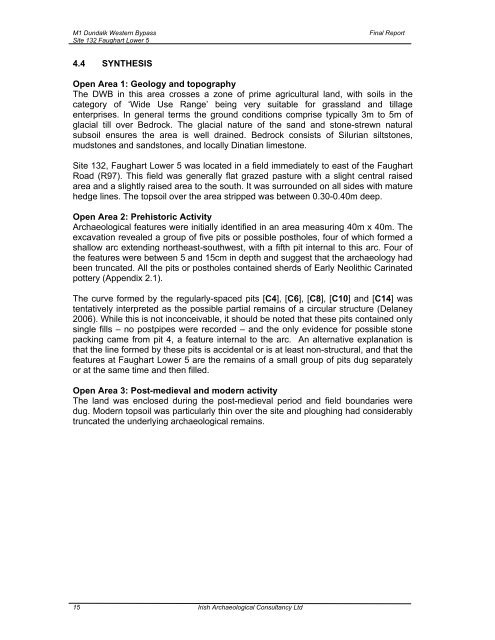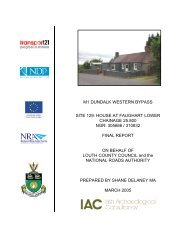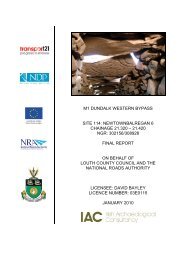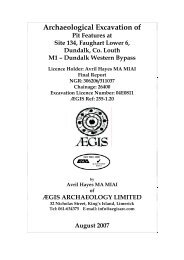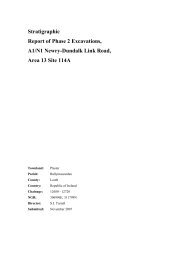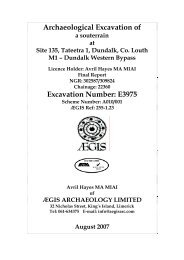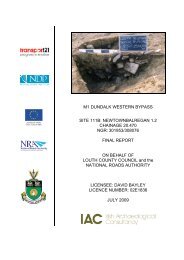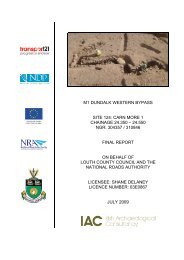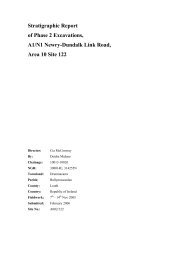Faughart Lower 5 Final Report - ASI Louth
Faughart Lower 5 Final Report - ASI Louth
Faughart Lower 5 Final Report - ASI Louth
You also want an ePaper? Increase the reach of your titles
YUMPU automatically turns print PDFs into web optimized ePapers that Google loves.
M1 Dundalk Western Bypass<br />
Site 132 <strong>Faughart</strong> <strong>Lower</strong> 5<br />
<strong>Final</strong> <strong>Report</strong><br />
4.4 SYNTHESIS<br />
Open Area 1: Geology and topography<br />
The DWB in this area crosses a zone of prime agricultural land, with soils in the<br />
category of ‘Wide Use Range’ being very suitable for grassland and tillage<br />
enterprises. In general terms the ground conditions comprise typically 3m to 5m of<br />
glacial till over Bedrock. The glacial nature of the sand and stone-strewn natural<br />
subsoil ensures the area is well drained. Bedrock consists of Silurian siltstones,<br />
mudstones and sandstones, and locally Dinatian limestone.<br />
Site 132, <strong>Faughart</strong> <strong>Lower</strong> 5 was located in a field immediately to east of the <strong>Faughart</strong><br />
Road (R97). This field was generally flat grazed pasture with a slight central raised<br />
area and a slightly raised area to the south. It was surrounded on all sides with mature<br />
hedge lines. The topsoil over the area stripped was between 0.30-0.40m deep.<br />
Open Area 2: Prehistoric Activity<br />
Archaeological features were initially identified in an area measuring 40m x 40m. The<br />
excavation revealed a group of five pits or possible postholes, four of which formed a<br />
shallow arc extending northeast-southwest, with a fifth pit internal to this arc. Four of<br />
the features were between 5 and 15cm in depth and suggest that the archaeology had<br />
been truncated. All the pits or postholes contained sherds of Early Neolithic Carinated<br />
pottery (Appendix 2.1).<br />
The curve formed by the regularly-spaced pits [C4], [C6], [C8], [C10] and [C14] was<br />
tentatively interpreted as the possible partial remains of a circular structure (Delaney<br />
2006). While this is not inconceivable, it should be noted that these pits contained only<br />
single fills – no postpipes were recorded – and the only evidence for possible stone<br />
packing came from pit 4, a feature internal to the arc. An alternative explanation is<br />
that the line formed by these pits is accidental or is at least non-structural, and that the<br />
features at <strong>Faughart</strong> <strong>Lower</strong> 5 are the remains of a small group of pits dug separately<br />
or at the same time and then filled.<br />
Open Area 3: Post-medieval and modern activity<br />
The land was enclosed during the post-medieval period and field boundaries were<br />
dug. Modern topsoil was particularly thin over the site and ploughing had considerably<br />
truncated the underlying archaeological remains.<br />
15<br />
Irish Archaeological Consultancy Ltd


